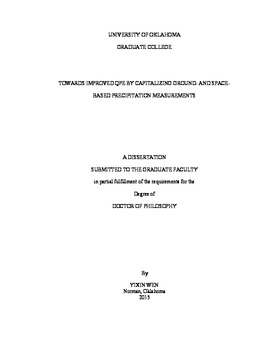| dc.contributor.advisor | Hong, Yang | |
| dc.contributor.advisor | Zhang, Guifu | |
| dc.contributor.author | Wen, Yixin | |
| dc.date.accessioned | 2015-05-20T17:07:50Z | |
| dc.date.available | 2015-05-20T17:07:50Z | |
| dc.date.issued | 2015-05-08 | |
| dc.identifier.uri | https://hdl.handle.net/11244/14634 | |
| dc.description.abstract | There are primarily two types of weather radar systems offering precipitation measurements covering relatively large areas: (1) Ground-based Radar (GR) networks such as the NEXRAD and (2) Spaceborne radars onboard meteorological satellites. Ground-based polarimetric weather radar is arguably the most powerful validation tool that provides physical insight into the development and interpretation of space-borne weather radar algorithms and observations. To achieve the synergy between ground- and space-borne weather radar, this study first aims to compare and resolve discrepancies in hydrometeor retrievals and reflectivity observations between the NOAA/National Severe Storm Laboratory (NSSL) “proof of concept” polarimetric WSR-88D radar (KOUN) and the space-borne precipitation radar (PR) onboard NASA’s Tropical Rainfall Measuring Mission (TRMM) platform. The comparisons reveal an overall bias <0.2% between PR and KOUN. The bias is hypothesized to be from non-Raleigh scattering effects and/or errors in attenuation correction procedures applied to Ku-band PR measurements. Provided the upgrade of the U.S. national weather radar network to include polarimetric capabilities, the findings in this study will potentially serve as the basis for nation-wide validation of space precipitation products and also invite synergistic development of coordinated space/ground multisensor precipitation products.
On the other hand, due to inadequate radar coverage from intervening terrain blockages, ground QPE needs enhancement aided by spaceborne radars. In the second part of the talk, I will introduce an approach that identifies and corrects for vertical profile of reflectivity (VPR) by using TRMM PR measurements in the region of Arizona and southern California, where ground-based NEXRAD radars are difficult to obtain reliable ground precipitation estimation due to complex terrain and limited radar coverage. A VPR Identification and Enhancement (VPR-IE) method based on the modeling of the vertical variations of the equivalent reflectivity factor using a physically-based parameterization and climatological information is employed to obtain VPRs at S-band from the TRMM PR measurement at Ku-band. The VPR-IE methodology is comprehensively evaluated with all stratiform precipitation events in cold season in the year of 2011. The results show that the VPR-IE has overall good performance and provides much more accurate surface rainfall estimates than original radar QPE in NMQ system. With the recent availability of GPM Dual-frequency PR, the VPR-IE approach is anticipated to be more robust and more useful by extending to higher latitude mountainous regions. | en_US |
| dc.language | en_US | en_US |
| dc.subject | Meteorology | en_US |
| dc.subject | Remote Sensing | en_US |
| dc.subject | Quantitative Precipitation Estimation | en_US |
| dc.title | TOWARDS IMPROVED QPE BY CAPITALIZING GROUND- AND SPACE- BASED PRECIPITATION MEASUREMENTS | en_US |
| dc.contributor.committeeMember | Gourley, Jonathan | |
| dc.contributor.committeeMember | Palmer, Robert | |
| dc.contributor.committeeMember | Zhang, Jian | |
| dc.contributor.committeeMember | Wang, Naiyu | |
| dc.date.manuscript | 2015-05-02 | |
| dc.thesis.degree | Ph.D. | en_US |
| ou.group | College of Atmospheric & Geographic Sciences::School of Meteorology | en_US |
| shareok.nativefileaccess | restricted | en_US |
